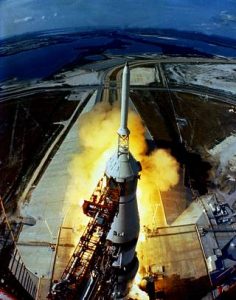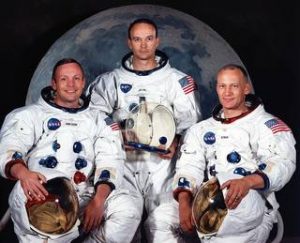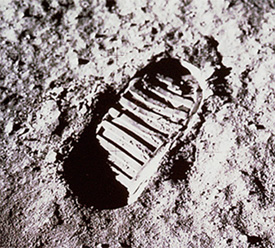Most of us at one stage of our life wanted to become an astronaut. One of the incidents that inspired us so and continues to inspire so many young space enthusiasts is the moment when 3 men backed by so many other experts strived to take that “one small step for a man”, the words of Neil Armstrong.
Fifty years ago, on 20th July 1969 Commander Neil Armstrong and module pilot Buzz Aldrin became the first 2 humans to ever land on the Moon aboard the Apollo 11 Lunar module Eagle.
Neil Armstrong was the first man to step on moon later on the 21st of July on U S time, and Aldrin joined him several minutes later. They had spent about two and a quarter hours on the moon and collected 21.5 kg of soil for analysis. Meanwhile, module pilot Michael Collins controlled the module Columbia by himself in lunar orbit.

Saturn V rocket with the Apollo 11 space vehicle @ www.nasa.gov
The Spacecraft
Apollo 11 was launched aboard rocket Saturn V from the Kennedy Space Centre on Merritt Island, Florida, on 16 July 1969. There were 3 main parts to the spacecraft. They were the command module which carried the cabin of the 3 astronauts, the service module which supported the command module with power, oxygen and propulsion as well, and the lunar module to bring and take the astronauts to and from the moon.
The command module was the only part that returned to Earth. Michael Collins was in charge of this and he remained orbiting the moon in the command module while the other two landed on its surface. The lunar module had 2 stages. The descent stage was to land safely on moon and the ascent stage was designed to get the astronauts back into lunar orbit. Buzz Aldrin was assigned the module pilot for the lunar module.
The lunar module was named Eagle after the Apollo 11 emblem and the Commanding module Columbia after the he giant cannon that launched a spacecraft (also from Florida) in Jules Verne’s 1865 novel From the Earth to the Moon. Michael Collins had referred the name to Christopher Columbus.

The Apollo 11 astronauts, from left, Neil A. Armstrong, commander; Michael Collins, command module pilot; and Edwin E. “Buzz” Aldrin Jr., lunar module pilot @ www.nasa.gov
The Sea of Tranquility
After its launch into space by Saturn V the spacecraft was separated from it and took 3 days to enter to the lunar orbit. While Collins commanded the spacecraft in the lunar orbit, Armstrong and Aldrin moved to the lunar module Eagle and landed in the sea of tranquility. The sea of tranquility is the site on moon where they landed. The name was coined by the 2 aboard the module and first announced by Armstrong at the touchdown as “Houston, Tranquility Base here. The Eagle has landed”.
Tranquility base was the second point out of 5 landing points near lunar equator narrowed down from 30 points picked through high resolution photographs for over 2 years. Because the landing points were not exactly predictable they were elliptical target areas of 11 miles East to West and 5 miles North to South. The automated targeting system had been taking the module to a crater off track due to errors that occurred with the landing thrust when Armstrong took manual control and landed the module within the targeted ellipse.
Armstrong and Aldrin spent 21 hours at the tranquility base and they left about 100 random items there at the place including their footprints. Module’s descent stage was left there at the takeoff and several other items such as cameras, Aldrin’s boots were left on moon to reduce the weight on the trip back home. Also, a disc containing Apollo 11 goodwill messages, a solar powered seismometer that stopped working after 21 days, and a laser reflector were also left on moon. It is said that though they left the famous flag from the footage on moon, Buzz Aldrin had claimed to have seen it fall from the thrust exerted by their module as they left.

Astronaut Edwin E. “Buzz” Aldrin Jr., lunar module pilot, descending the steps of the Lunar Module. credits: Neil Armstrong @ www.nasa.gov
The Mission Emblem
The mission emblem was designed by Michael Collins who wanted to make the statement peaceful lunar landing by United States. It shows a bald eagle landing on moon with an olive branch at its feet and has the Earth at its background. Armstrong and he chose blue and yellow for the border. The astronauts decided not to put their names on the emblem wanting it to represent everyone who worked for the project.

The Return Back Home
Aircraft carrier USS Hornet was selected as the primary recovery ship for Apollo 11. On July 24, Columbia struck the water forcefully east to Wake Island in Pacific Ocean. The astronauts were decontaminated with chemicals for the possibility of bringing pathogens from the lunar surface.
After their return and recovery on Earth, the trio were welcomed in procession. Like we all know their triumph was celebrated repeatedly till today through books and movies. There are some who still believe that the moon landing was a stage setup and did not happen for real. Despite all that the Apollo mission had gifted so much to the world. New technology, new knowledge, hope and inspiration for generations to dream on. It was at Apollo 11 mission that Margaret Hamilton worked as a pioneer software engineer. It was there that software was recognized as an important engineering field.
So far, Apollo has managed 6 successful landings on moon from 1969 to 1972. They have managed to bring the first geologist on moon. To this day, Apollo project is believed to be the most successful space mission.
References:
https://www.nasa.gov/feature/50-years-ago-apollo-astronauts-land-take-first-us-steps-on-moon
https://www.nasa.gov/mission_pages/apollo/missions/apollo11.html
Images Courtesy of:
https://www.nasa.gov/sites/default/files/styles/side_image/public/thumbnails/image/s69-34875_0.jpg?itok=Macm7Vch
https://www.nasa.gov/feature/50-years-ago-apollo-astronauts-land-take-first-us-steps-on-moon
Featured image Courtesy of:
https://www.nasa.gov/images/content/62043main_Footprint_on_moon.jpg

